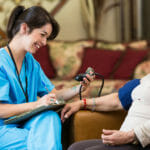The health challenges facing the American population have shifted dramatically in the twenty first century (Institute of Medicine [IOM], 2010). Nurses now need a higher level of education to properly address the needs of the aging population which has become more diverse with respect to race, ethnicity, socioeconomic and cultural factors (IOM, 2010). Nurses need to have the tools and have the proper educational foundation that will empower them to deal with the shifts in the entire nation’s health care needs (IOM, 2010). Keeping in mind the need for nurses that have their baccalaureate, masters or doctorate education, the United States has projected a shortage of more than 500,000 nurses by the year 2025 (American Association of Colleges on Nursing [AACN], 2008). To comprehend the needs of the nation and the need for nurses with higher education, the profession needs to be changed and viewed as a respected career. This change will generate new nurses and encourage existing nurses to stay in the profession and seek advanced degrees.
Due to changing demographics, increased cultural diversity in America, advancing technology, the need for evidence based practice and changing health care systems. Previously, nurses were thought to be technicians and strictly task oriented. Nurses now need to be leaders, and without the proper curriculum and education, nurses will not be able to embrace such a role. Curriculum development, ongoing evaluation, and redesigning of nursing education is crucial so that students can master the skills and knowledge necessary to become practicing nurses (Keating, 2011). The Essential of Baccalaureate and Masters of Nursing Education can also create a standard for nursing education in the United States and throughout the world. The bare concepts shared in these publications are being utilized in most nursing schools but only as a guide. By and large, these publications are not being used to create the school’s curriculum.
The Essential of Baccalaureate and Masters in Nursing Education could also hinder curriculum development. Both publications serve as a great guide to update and/or develop core nursing curriculum, but faculty may find it difficult to veer away from these publications or add additional curriculum. An example of this problem was how one professor felt that adding genomics to an already overburdened curriculum was not feasible (Prows, Glass, Nicol, Skirton, & Williams, 2005). Courses such as genomics to a baccalaureate or graduate level program would, in my opinion, be crucial to the curriculum. Baccalaureate and graduate nursing curriculum should allow for important courses such as genomics to be placed in the curriculum and not overlooked or ignored because of their specific absence in the above-referenced publications. Upper level nursing curriculum should only be guided by the two documents and not used to determine the only available courses for the degrees (AACN, 2008). Nursing faculty need to have some control over the curriculum, but this control should not veer so far from the essentials outlined in the publications that students are not educated or prepared for vital nursing skills.
The nursing profession can be elevated by advancing into baccalaureate and graduate education. Both the Essentials of Baccalaureate and the Essential of Master Education can be used as a guide to educate nurses in the changing health care system and create a standard for nursing education. The guides can hinder curriculum if faculty do not use the guides properly and use them as a course outline instead of a guide. These two publications can help further develop the nursing profession and impact the transformation of healthcare delivery to a safer, higher quality, and more cost effective system (AACN, 2008).
References
American Association of Colleges of Nursing. (2011). The Essentials of Master’s Education in Nursing. , 1-64. Retrieved from http://www.aacn.nche.edu/education-resources/MasEssentials96.pdf
American Association of Colleges on Nursing. (2008). The Essentials of Baccalaureate Education for Professional Nursing Practice. , 1-61. Retrieved from http://www.aacn.nche.edu/education-resources/BaccEssentials08.pdf
Institute of Medicine. (2010). The Future of Nursing: Focus on Education. The National Academies, 1-2. Retrieved from http://iom.edu/Reports/2010/The-Future-of-Nursing-Leading-Change-Advancing-Health.aspx
Keating, S. B. (2011). Curriculum Development and Approval Processes in Changing Educational Environments. In M. Zuccarini (Ed.), Curriculum Development and Evaluation in Nursing (2nd Edition ed., pp. 33-45). New York, NY: Springer Publishing Company.
Prows, C., Glass, M., Nicol, M., Skirton, H., & Williams, J. (2005). Genomics in Nursing Education. Journal of Nursing Scholarship, 37(3), 196-202. Retrieved from CINAHL with Full Text





